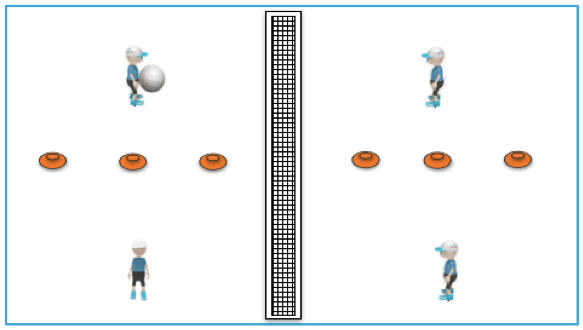TECHNIQUE
Today we are going to learn how to dig.
IMPORTANCE
Digging is important because it is a successful defense tactic to prevent the ball from hitting the ground after spiked from the opposing team. .
VOCABULARY
Bump: a passing move in volleyball (typically the first touch when the ball comes over).
When digging, it is important to:
1. Get in the ready position (feet shoulder width apart, knees bent, slight forward lean).
2. Create a platform with your arms (place one hand on top of the other and bring your thumbs together).
3. Stay on the balls on your feet and move to meet the ball.
4. Make contact with the ball on your forearms (not hands).
5. Follow through with your arms, moving them slightly upward and towards your target.
PRACTICE
- Move onto skills game– Four Square.
FOUR SQUARE
TIME
10-20 minutes
NUMBER OF STUDENTS
4 students per game
EQUIPMENT
1 volleyball per 4 students
10 short cones
1 net
OBJECTIVE
Today we are playing Four Square. In this game, the objective is to use a dig so that ball does not hit the ground in your square.
INSTRUCTIONS
- I will divide the class into teams of four.
- Ro Sham Bo to decide who starts with the ball first.
- When I say, "GO!" serve the ball over the net. Each hit must be made over the net.
- If the ball touches the ground, goes out-of-bounds, or hits the net a teammate receives a letter “S-Q-U-A-R-E”.
- Each new round, students will rotate clockwise.
- We will begin a new game after five minutes.
Game 1: Play as indicated above.
Game 2: Students can hit the ball to any square of their choosing.
Game 3: Elimination round – if the ball touches the ground in your square then you are eliminated.
Exit Ticket: Teacher will hit the ball over the net for students to demonstrate a dig before putting the equipment away.
TEACHING TIPS
- Approach:
- Increase the number of teams based on class size. Divide students into competitive and non-competitive groups.
- ELL Accommodation:
- Post labeled pictures of skills and game play.
- Partner with proficient English speakers for directions/modeling and reflections.
- SpEd Accommodation:
- Set individual goals for physical or behavioral modifications.
- Allow students to demonstrate skill one-on-one with teacher.
- Allow students extra time to master the skill.
- Reflection:
- Why is digging the ball so important?
- What is one way you can improve your digging form?
TAKE OUT
TIME
15-25 minutes
NUMBER OF STUDENTS
12-20 students per game
EQUIPMENT
1 volleyball per 12 students
1 net
OBJECTIVE
Today we are playing Take Out. In this game, the objective is to use a dig to prevent the opposing team from getting you and your teammates out.
INSTRUCTIONS
- I will divide the class into teams of six.
- Ro Sham Bo to decide which team will serve first.
- Decide with your team where each of you will stand on the court.
- When I say, “GO!” serve the ball over the net until the ball goes out-of-bounds or hits the grounds.
- Each team can hit the ball three times.
- The student that misses the ball or hits the ball out-of-bounds is out and has to wait on the sidelines.
- The team that losses will serve next.
- Servers rotate in a clockwise position.
- We will begin a new game when all teammates on one team are out.
Exit Ticket: Teacher will hit the ball over the net for students to demonstrate a dig before putting the equipment away.
TEACHING TIPS
- Approach:
- Have teams rotate courts – every student will get to play on the net.
- Set up:
- Use short cones in replacement of a net for additional courts.
- ELL Accommodation:
- Post labeled pictures of skills and game play.
- Partner with proficient English speakers for directions/modeling and reflections.
- SpEd Accommodation:
- Set individual goals for physical or behavioral modifications.
- Allow students to demonstrate skill one-on-one with teacher.
- Allow students extra time to master the skill.
- Reflection:
- Why is digging the ball so important?
- What is one way you can improve your digging form?
CHALLENGER
TIME
10-20 minutes
NUMBER OF STUDENTS
4-24 students per game
EQUIPMENT
1 volleyball per court
1 short cone
1 net
OBJECTIVE
Today we are playing Challenger. In this game, the objective is to use a dig during your challenge with the all-star team.
INSTRUCTIONS
- I will divide the class into teams of three.
- I will choose one team to begin as the all-stars.
- Everyone else will form a single-file line with on one of the court.
- The all-stars will compete against the other teams until a challenging team wins.
- When I say, “GO!” the all-stars will serve to the first challenging team in line.
- A serve is awarded on every serve. The first team to earn three points wins.
- The team to win the rally will stay on the court and the next challenging team in line will play.
Game 1: Play as indicated above.
Game 2: Decrease or increase the amounts of points teams have to earn to win the game.
Exit Ticket: Teacher will hit the ball over the net for students to demonstrate a dig before putting the equipment away.
TEACHING TIPS
- Approach:
- Depending on class size, add additional courts using short cones.
- ELL Accommodation:
- Post labeled pictures of skills and game play.
- Partner with proficient English speakers for directions/modeling and reflections.
- SpEd Accommodation:
- Set individual goals for physical or behavioral modifications.
- Allow students to demonstrate skill one-on-one with teacher.
- Allow students extra time to master the skill.
- Reflection:
- Why is digging the ball so important?
- What is one way you can improve your digging form?








